
MARS STRANGE BIO-LIFE 3a
Report #147
September 21, 2008
can be contactee at:
This report is a supplement to the previous Report 145 and Report 146 where different versions of this type of Mars biological life evidence, all oriented on water, are presented and discussed. Sometimes this type of evidence appears as parallel very light reflective ridge forms, sometimes as frozen appearing waterfalls, sometimes as irregularly round shaped pit formations, and sometimes with the look you see below as a variation of the ridge form evidence.
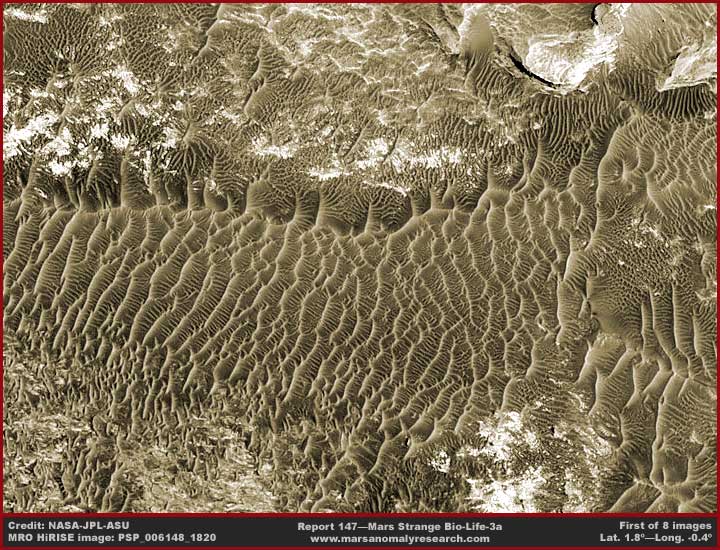
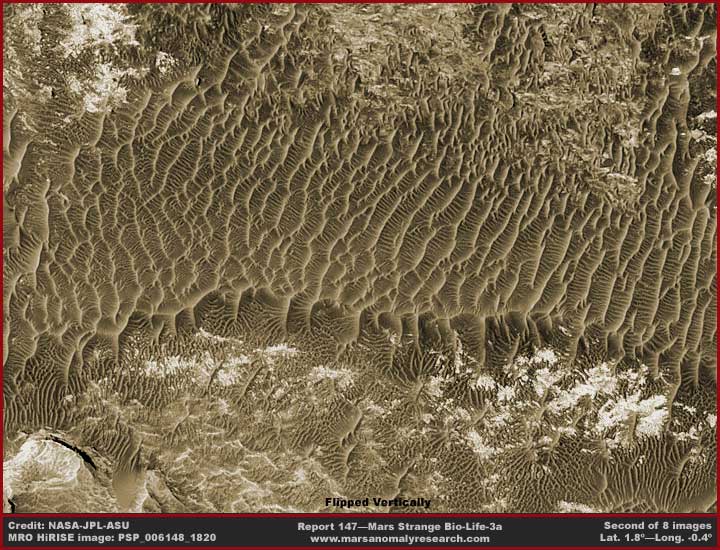
All evidence in this report is based
on the browser compatible .jpg imaging. The above 1st and 2nd images demonstrate
two different views of the same evidence scene. The 1st is the official science
data orientation view and the second is a vertically flipped view of the same
scene.
What you are looking at is a Mars life form that capitalizes on plentiful
water presence in order to survive and proliferate. It is the ridge
form evidence previously reported on but with a visually obvious difference.
That visual difference is the presence of very pronounced visually apparent
many smaller branching ridges running at 90º angle to any one main ridge
but still oriented roughly parallel to each other. If you will look back primarily
in the 2nd and 8th images in REPORT
#145, you will see main ridge form evidence that either doesn't
appear to have or does have very subdued versions of this 90º angle branchings.
So why the difference? That may be a function of slight variations in the
species but I can't answer that one with any confidence. What I can say with
confidence is that the ridge form appearance, as I have stated in prior reporting,
is at least in large part due to the type of water conditions present and
on what kind of terrain.
For example, when shallow water flows reliably and consistently down a slope,
whether short or long or narrow or broad, the type of ridge forms will form
on that slope to the extent that the shallow water flows on it taking on the
look similar to that in the 2nd and 8th images in Report #145. When the water
flow down that slope is less reliable and/or more sporatic, the ridge form
formations will change and try to retard and/or block and/or catch and temporily
hold that flow.
In the above scene, it is likely that water has flowed down a very gradual
slope reliably enough in the past for the main ridge forms to form into a
major presence there. However, changing conditions have either reduced and/or
made the flow sporatic and the ridge forms have no choice but to additionally
developed these side ridges as branchings across the flow trying to retard
and hold onto this water rather than just channel it in a single direction
down the slope.
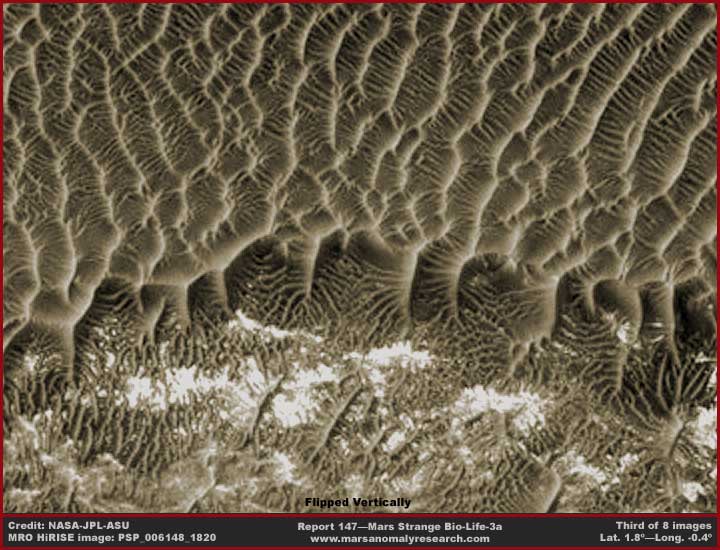
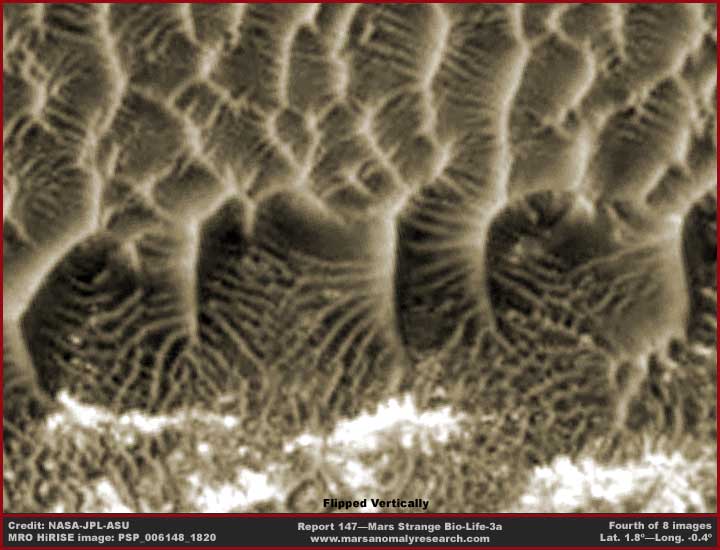
The down slope would be from the
top of the 2nd image to its bottom. How do I know the direction of the slope
when it isn't visually readily apparent? The answer is in the life form evidence.
Note the closer 3rd image view but especially the closest above 4th image
view of the evidence.
At the foot of the slight slope and down slope outer edge of the main ridge
form field, the life form presence there is attempting not entirely successfully
to reform into pit formations that I reported on in Report #145. That suggests
that it is having to increasingly retard the water presence because most of
the water has been blocked and/or used up in the field of evidence above it
and is less plentiful and nutrient rich reaching this bottom slope point.
I know that this all looks very strange and reads very strange for many of
you no doubt triggering unfamiliarity that leads to uncertainty and thereby
doubt. That can't be helped but just remember that you are are looking at
a different world here with its own individual evolutionary paths quite different
from Earth. It is a world once covered with plentiful water resources that
are now seriously diminished relative to the distant past. What evolved in
Mars ancient seas may have adapted and evolved over millions of years into
what we are looking at now and still taking advantage of now more limited
water resources.
The one thing that you can do is look
very carefully at the strange evidence in the above closer view 4th image.
You know as well as I do by the simple process of elimination that we are
not looking at any form of inanimate geology here. I know it and deep inside
you know it and even deeper inside the science and academic communities around
the world know it to. It is just that most are afraid to buck the tide and
risk their professional careers.
Why is that perceived as a risk? Because it is a little too fantastic and
differing from the norm of what they are used to. Further, they know or suspect
the secrecy agenda forces that are arrayed against revealing the truth and
no one wants to get out on that limb alone and take a beating from them. If
you in the public ever get fed up enough with the secrecy and deceit to collect
together in sufficient numbers to do something about this, individuals from
the science and academic communities will then begin to get enough gumption
to join in with the community you represent and add their two cents.
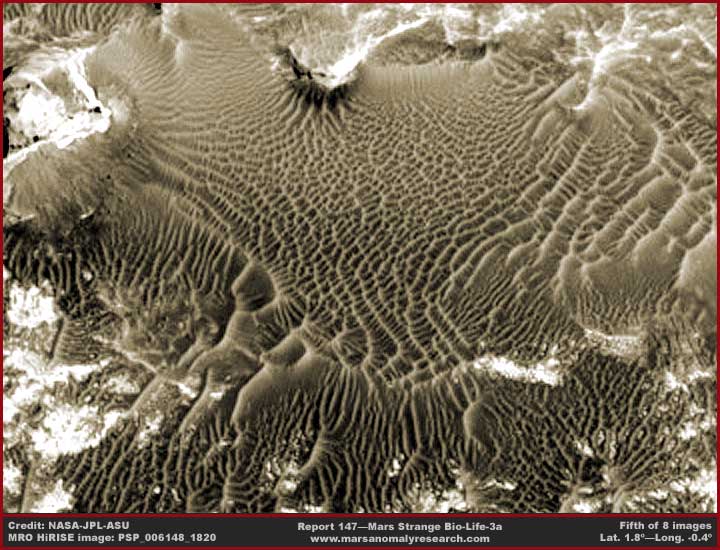
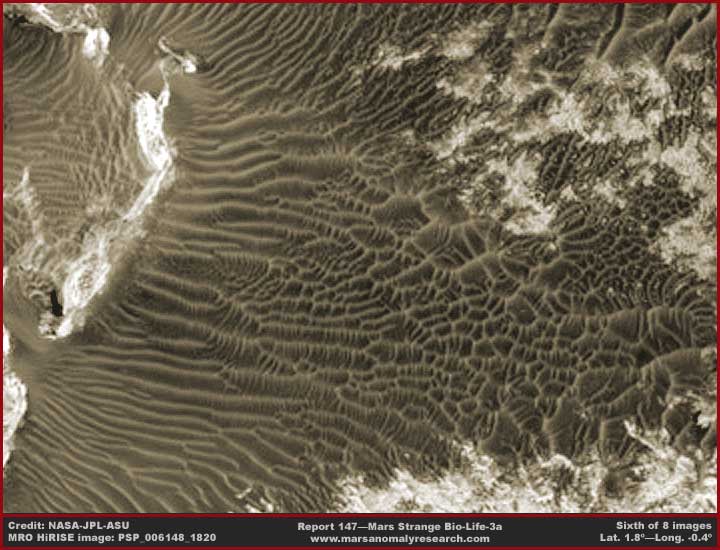
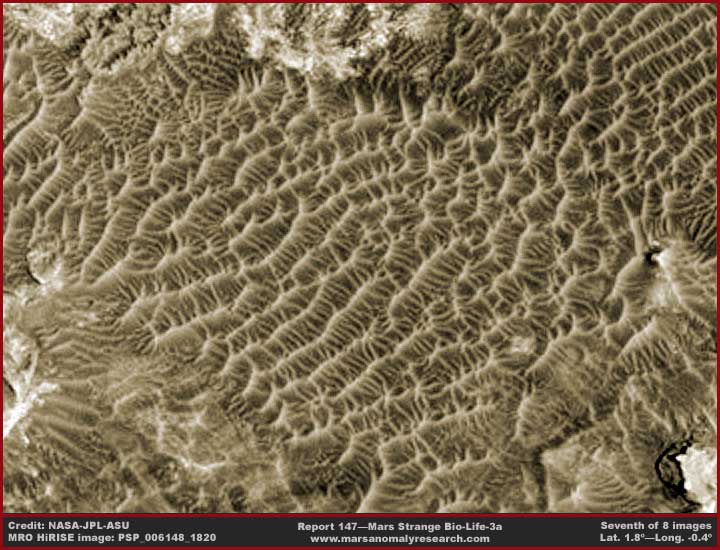
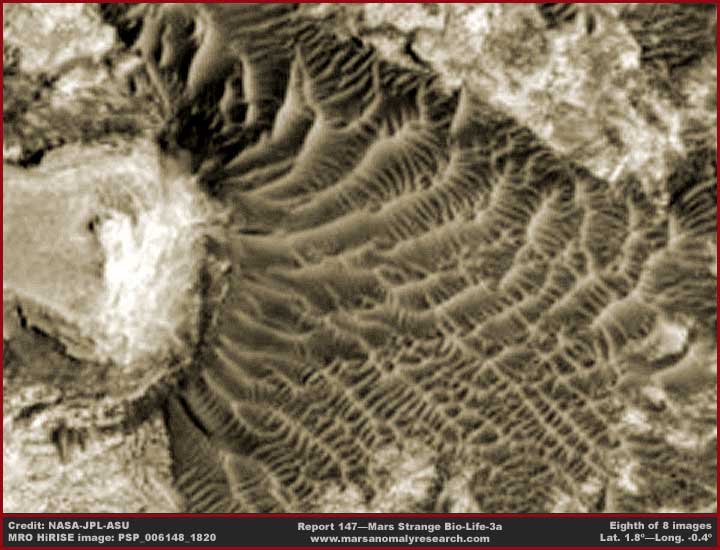
The above 5th, 6th, 7th and 8th images
offer different views of this evidence and its many slight variations influenced
by variations in the terrain and water availability in any one location. In
the above 8th image as an example, please note the obvious geological land
formations in the scene on the left and then search this type of geological
presence out in the other images here to recognize the difference between
geology and life.
Note how rock and soil geology is more light reflective than the ridge form
evidence. This is typical of inanimate rock and soil geology. Now note how
dull and light absorbing all of the ridge form evidence is. This is typical
of life that needs to absorb solar energy. Remember that, no matter any arguments
about the true Mars tempertures, this is in basic not a warm world and solar
energy absorption would be especially essential to life on the surface of
this world with its generally colder temperatures relative to that experienced
here on Earth.
The evidence we are looking at here is not vegetation but almost certainly
some major form of colony life that has survived because it has been able
to adapt to changing environmental conditions to a significant degree. It's
still total reliance on water presence even more so than any form of vegetation
we are familiar with is distinct and likely suggests an ancient sea origin.
We can't of course know at this point but I would not be in the least surprised
to learn that it has kinship roots with ancient Mars reef building polyps.
This evidence is very extensive all over the Mars landscapes. This suggests
that at least residual surface water and just below ground level water presence
is also extensive all over the Mars landscape as well but often covered by
these formations taking advantage of it.
DOCUMENTATION
http://hirise.lpl.arizona.edu/PSP_006148_1820:
This link takes you to the official MRO PSP_006148_1820
science data .jpg image that is the single source for all of the image evidence
in this report. Note that I used the second listed "full
image (grayscale non-map projected)" browser
compatible .jpg image as my source for ease of verification for the
greatest number of viewers rather than the JP2 imaging that some of you perhaps
cannot access very readily. The next Report 148 will include JP2 imaging of
some of this same evidence as well as new evidence revealed by the higher
resolution.
, Investigator
![]()